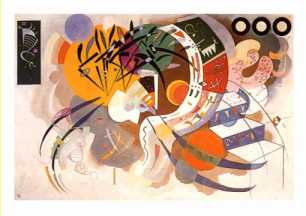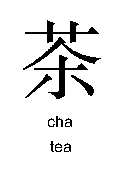 W. Kandinsky, Dominant Curve, 1936
W. Kandinsky, Dominant Curve, 1936
Back to Main Page | |||||
|
Favorite Sites |
Computing |
Education |
News |
Jobs |
Israel |
|
Business |
W3 Resources |
History |
Travel |
Internet |
Russia |
|
Entertainment |
Books |
Art |
Science |
Languages |
Spanish |

 W. Kandinsky, Dominant Curve, 1936
W. Kandinsky, Dominant Curve, 1936

 the Shen Nong (or Shen Nung)
, an early emperor was a skilled ruler, creative scientist and patron of the arts.
He was called “The Divine Healer.” Numerous other medicinal plants were attributed
to this legendary emperor. His far-sighted edicts required, among other things,
that all drinking water be boiled as a hygienic precaution.
One summer day while visiting a distant region of his realm, he and the court
stopped to rest. In accordance with his ruling, the servants began to boil water
for the court to drink. Dried leaves from the near by bush fell into the boiling
water, and a brown liquid was infused into the water. As a scientist, the
Emperor was interested in the new liquid, drank some, and found it very
refreshing. And so, according to legend, tea was created.
the Shen Nong (or Shen Nung)
, an early emperor was a skilled ruler, creative scientist and patron of the arts.
He was called “The Divine Healer.” Numerous other medicinal plants were attributed
to this legendary emperor. His far-sighted edicts required, among other things,
that all drinking water be boiled as a hygienic precaution.
One summer day while visiting a distant region of his realm, he and the court
stopped to rest. In accordance with his ruling, the servants began to boil water
for the court to drink. Dried leaves from the near by bush fell into the boiling
water, and a brown liquid was infused into the water. As a scientist, the
Emperor was interested in the new liquid, drank some, and found it very
refreshing. And so, according to legend, tea was created.
 Shen Nong
Shen NongBased on the medical book 'Pen Tsao', attributed to Shen Nung, there are references which credit tea with being 'good for tumors or abscesses that come about the head, or for ailments of the bladder. It dissipates heat caused by the phlegm, or inflammation of the chest. It quenches thirst. It lessens the desire for sleep. It gladdens and cheers the heart'.
Shen Nong is also credited for developing the theory of "opposing natural forces" which would later play an important part in Taoist philosophy.
Almost 3,000 years later, Confucius was the first to really apply Shen Nong's theory of opposing forces. Confucius declared that it was man's responsibility to live a moral and just life, that by following a code of ethics and behavior, man could influence the opposing poles of good and evil that maintain the order of the universe. Gradually, the theory was expanded to describing everything in the universe as opposite poles - Yin and Yang - hot and cold, black and white, passive and aggressive and so on.
Lao Ziu translated Confucius' views of universal order into his own philosophy. Lao Ziu believed that man shouldn't interfere with fate, that the universe should be allowed to follow its destined the path (Tao). Lao Ziu's theories became hugely popular, gaining many followers, and gathering momentum until the religion called now known as Taoism was born. Despite Lao Ziu's basic theory of noninterference and allowing the natural order of events to take place, Taoists composed guidelines or a path (Tao), which when followed, eventually led to the "Great Tao" or the AbsoluteExternal.
Taoism became more than a religion, it became a blueprint of life. Taoists believed that man was a universe unto himself. Not only did a disciple of Taoism learn a moral code to follow to reach universal harmony but he also learned what foods to eat and what herbs to take to reach an internal harmony. Following the principles of Yin and Yang, hot and cold, Taoists began categorizing foods by their properties. They recommended "cold" foods such as fruit, vegetables, crab and fish to reduce heat in the body and "hot" foods such as fatty meats, eggs, spicy and fried foods to increase heat and vitality in the body. They soaked medicinal plants and herbs in alcohol, creating Yin and Yang, hot and cold, balancing tonics. These early tonics are the roots from which evolved the pills, creams and potions that comprise the pharmacopoeia of traditional Chinese herbal medicine today.
 Sui Dynasty
Sui Dynasty Tang Dynasty
Tang Dynasty Pu-er or Tuocha teas).
Pu-er or Tuocha teas).
Lu Yu's work clearly showed the Zen Buddhist philosophy to which he was exposed as a child. It was this form of tea service that Zen Buddhist missionaries would introduce to imperial Japan.
 Sung Dynasty
Sung DynastyThe tea began to be not a poetical pastime, but one of the methods of self-realisation. Tea rooms and houses were built in order to enjoy tea at a social and spiritual level. There were even competitions among tea connoisseurs who were judged on the way they conducted their ceremony and on the quality of the tea leaves, water, and brewed tea. The art of making ceramic tea equipment was developed a great deal during this period. Tea bowls became deeper and wider to aid in the whipping. Since the prepared tea had a very light green hue, black and deep blue glazes were used on the bowls to enhance the tea color. The most famous style of these bowls was a black bowl with lines running down the bowl called rabbits fur. royal philosophy dominated this period and tea preparation became less complicated and more peaceful. The Japanese art of tea has its roots from this era.
 The sudden outburst of the Mongol tribes in the thirteenth century resulted in the devastation, destroyed all the fruits of the Sung culture.
Manners and customs changed to leave no vestige of the former times. The powdered tea is entirely forgotten.
The sudden outburst of the Mongol tribes in the thirteenth century resulted in the devastation, destroyed all the fruits of the Sung culture.
Manners and customs changed to leave no vestige of the former times. The powdered tea is entirely forgotten.
 Gong Fu(chinese - skillful) has been passed down to the present day from the days of Ming
Dynasty Emperor Shen Tsung in 16th century China, so it boasts a 400-year
history. The full aroma and sweetness of the tea can be brought out when using a
small teapot to steep tea. During the Ming (1368-1644) and Ch'ing (1644-1911)
dynasties, the purple clay ceramic teapots of Yihsing, Kiangsu were the most
famous.
Gong Fu(chinese - skillful) has been passed down to the present day from the days of Ming
Dynasty Emperor Shen Tsung in 16th century China, so it boasts a 400-year
history. The full aroma and sweetness of the tea can be brought out when using a
small teapot to steep tea. During the Ming (1368-1644) and Ch'ing (1644-1911)
dynasties, the purple clay ceramic teapots of Yihsing, Kiangsu were the most
famous.
 the Tang dynasty (618-907 ad) in China,
where a combination of easily accessible raw materials and superior kiln design resulted in the ceramic
industry being many centuries in advance of the West.
the Tang dynasty (618-907 ad) in China,
where a combination of easily accessible raw materials and superior kiln design resulted in the ceramic
industry being many centuries in advance of the West.
 Chinese Tea Ceremony
Chinese Tea Ceremony
 Taiwan site on Chinese culture
Taiwan site on Chinese culture
 Hua Ming Tea Company : Chinese tea history
Hua Ming Tea Company : Chinese tea history
 Gray and Seddon : Chinese tea classification
Gray and Seddon : Chinese tea classification